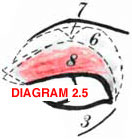Robert Hill Long
American Tire
Blood
bone and bile: primary colors I see when
I change to snow tires in fall. Why does a dealer
paint his business in bone, and bile, and blood, unless
in his guts he knows how many of us will wreck
and mangle rods, fluids, struts.
Little engine,
automatic will and longing that forever
drives toward the thing it can’t steer past, like black ice
on some obscure mountain pass: the botched mosaic
of glass and self and burst black tread. What changes when
I change my tires? Not the end page of this severe,
short operator manual for happiness:
it has to close on the hero straining to suck
a liter of indifferent air through
his teeth,
his mountain whitewalled with snow: nameless wreath.
____
I live close enough
to the Cascades to make a winter habit of skiing. Anyone who has done
mountain driving in the winter has known moments of whiteout terror and
black-ice fright. There's nothing like inching down icy switchbacks, with
a name like Tombstone Pass, in the black dark and seeing in the rearview
mirror several sets of headlights begin to veer slowly in all directions
as the tires lose grip and a car slides pastyou sideways into the next
car down, and not too far ahead an eighteen-wheeler starts to scissor
across both lanes of the road and you know you somehow have to turn around,
thread through the half-ditched cars, and find another pass that will
get you home before the next morning. This poem starts from the American
romance with cars, the way they become an armored ego-projection, and
applies mortal logic to the personification. The colors in the first line
are based on Les Schwab Tires, a franchise throughout the mountain west
whose buildings are painted yellow, red, and white—and where I have
my studded tires mounted each December.
